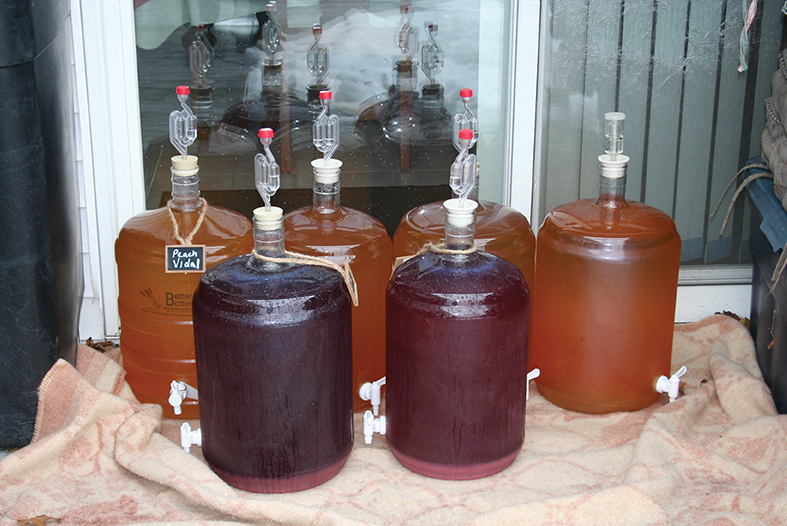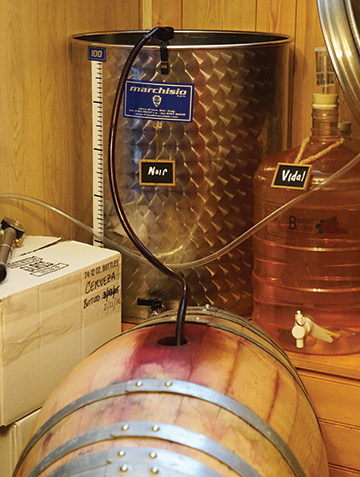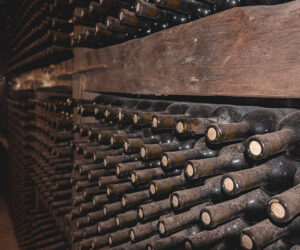As winter arrives in North America, wines of the previous harvest are finished fermenting and are somewhere along the cellaring timeline. If you made white, rosé, or red wine from fresh grapes or juice this vintage, here are some tips to check in on your young wine and make sure it continues to develop to its best potential. While execution and timing differ for different wines and storage conditions, three basic areas need to be considered for almost every wine. These are sulfite management, stabilization, and racking decisions. The most common vessels for cellaring new wines are carboys, tanks, and barrels.
Sulfite Management
White wines can be prone to oxidation and browning even early in the cellaring period. Because of that vulnerability, the recommended sulfite maintenance level is 0.8 ppm (mg/L) of molecular SO2 as compared with a recommendation of 0.5 ppm in red wines. Once primary fermentation of your white wine is complete — or when malolactic fermentation (MLF) is done if you are applying it — it’s time to rack the new wine off the lees into topped-up containers. It is essential that all fermentation is complete before you start your program of sulfite maintenance. While guidance varies from different sources, I consider a residual sugar analysis of less than 4 g/L (0.4 g/100 mL or percent) to be a dry wine and stable against refermentation. For MLF, look for a level below 0.1 g/L (100 ppm) of malic acid or a complete absence of a malic spot on a paper chromatography test.
Once completion is verified, add 30–50 ppm of sulfite. Use your wine’s pH value and the 0.8 ppm molecular SO2 target to find the recommended level for maintaining free SO2 during aging. There is a sulfite addition calculator at www.winemakermag.com/sulfitecalculator and in various home winemaking books.
A week or two after the racking and topping up, measure your free SO2 level and make any addition needed to reach your maintenance goal.
About once a month through the winter, test again and make needed additions. In my experience, sulfite demand in white wine decreases after the first couple of monthly additions, leading to much smaller make-up additions later in the season. I have found that carboys, either PET plastic or glass, hold their sulfite levels quite well. Some tanks, like the ones that feature variable capacity with a removable lid, seem to use up free sulfite somewhat faster than carboys so you may need more frequent additions, especially early in the aging process. Checking these variable capacity tanks is also a wise idea as gaskets sometimes deflate without the winemaker knowing, which can lead to oxidation if not caught. Barrels are less common for white wine cellaring than for red, with barrel-aged Chardonnays being something of an exception. Like a tank, a barrel may undergo rapid loss of sulfite early in aging, but the rate diminishes with further aging.
Stabilization

Beyond complete fermentation and sulfite maintenance, white wines may also need cold stabilization. The tartaric acid native to grapes is less soluble in an alcohol solution (wine) than in juice. It is also less soluble at cold temperatures. That means chilling a white wine may cause a potassium salt of tartaric acid — potassium acid tartrate — to precipitate out and deposit on container walls or, if already bottled, on the underside of the cork. While there are laboratory tests for that condition, it is easiest to just cold stabilize your white wine to whatever temperature you intend while it is cellaring. Place topped-up containers in a refrigerator set to the desired temperature or expose to cold nighttime temperatures (avoid sunlight) for several days or up to two weeks. Tartrate deposits — sometimes colorfully referred to as “wine diamonds” — may form in the bulk container and protect your later bottled wine from this problem.
Racking Decisions
Since you may now have tartrate deposits on the walls of your carboy, tank, or barrel, we are led to the next phase of our mid-winter check-in: Racking decisions. Removing the clearing wine from lees that have dropped out has benefits and risks. The largest benefit is that you cannot be sure a wine has stopped “throwing” sediment until you see that result: Clear wine that does not produce more lees. It will also help a wine that needs degassing. The biggest risk is that exposure to air may allow oxidation and browning. That risk is also why it is essential that each new container is topped up with the same wine or a compatible vintage. After a white wine is racked off the lees from yeast fermentation, it is possible that you will rack it only two or three times on its way to the bottle. If you see substantial lees a few weeks after the first racking, rack and top up again. If significant lees form again, consider a late-winter racking to a clean vessel (top up and sulfite!). If only fine lees form, you can do your last racking in early spring as you rack to a bottling bucket or tank and bottle the wine. To filter your white wine before bottling, bottling day is a good stage to include that step to minimize extra handling of the wine. If you have been monitoring and maintaining your sulfite levels during cellaring, add 10 ppm more sulfite to the bottling tank as you bottle to make up for air contact during final processing.
Rosé Considerations
Rosé wines differ from white wines in the key stage of crushing. Made from red (or black) varieties often used for red wine production, the destemmed and crushed must remains in contact with the pigmented skins long enough to produce the pink color the winemaker desires. At that time, the juice is pressed off and the rest of the process is essentially identical to that of white wine. In my rosé wines, I have noticed a decrease in the pink color intensity during fermentation and cellaring. I recommend that you allow the skin contact to continue until the juice looks just a bit darker than you want your wine to be, then press off the juice.
With some small presence of tannins, these pink wines may be slightly more resistant to oxidation than white wines. However, they also tend to turn from floral pink shades to more coral or salmon orange hues as they age, putting off some wine drinkers. These wines are almost never put through MLF, so you will probably be racking, topping up, and sulfiting as soon as primary fermentation is complete. Verify completion just as for a white wine and initiate your sulfite maintenance program using the white wine standard of 0.8 ppm of molecular SO2. Since pink wines are served chilled, the same cold stabilization concerns as for white wine apply. Chill in bulk to your anticipated serving temperature and rack off of any tartrates that appear. In terms of racking for clarity and stability, the same evaluation and decisions as white wine will usually apply. Two or three rackings prior to bottling day will usually suffice, with more racking running the risk of oxidation. While most commonly bottled in clear flint glass to show off its pretty pink color, rosé is better protected from sunlight damage if packaged in a dark bottle.
Red Considerations

After you pressed off your red wine must at or near the end of primary fermentation, the new wine still contains some solid materials. Since most red wines undergo MLF, you may have done that on the skins by co-fermenting or you may have inoculated the pressed wine with an MLF culture. As that process probably took no more than three to six weeks, here at our mid-winter check-in you have racked off of the malolactic lees into topped-up carboys, tanks, or barrels. Just as with white or pink wine, verify complete dryness and, if applied, MLF completion before beginning your sulfite program for cellaring.
With some natural protection from oxidation provided by the native tannin content, a lower maintenance level of molecular sulfur dioxide should adequately protect an aging red wine. Using the target level of 0.5 ppm molecular and the pH of your wine, choose the free SO2 level as determined in the online calculator. As red wine aging tends to run longer than that for white or rosé wine, testing your cellared red for sulfite level about every other month can probably provide sufficient stability.
Red wines are rarely served chilled and cold stabilization is not generally needed. While long aging in the bottle may cause tartrate crystals to form on the cork, most wine drinkers are familiar with that condition and do not consider it a major flaw. It probably helps that the crystals that form in red wine are deeply colored and are not as easily mistaken for glass fragments as the “wine diamonds” of white wines are. With natural resistance to oxidation and less need for cold stabilization, the most likely stability concern with red wine in the cellar is continued production of sediment. Two or three months after confirming completion of fermentation and managing your sulfite program, it will be time for your first racking in the cellar. For carboys, I highly recommend having on hand one or more extra carboys of the sizes you need so you can easily rack directly from one to another. If you have multiple carboys of the same wine to rack, you may be able to wash and sanitize a just-emptied carboy to refill further along the process. If tartrates have formed on the glass or PET plastic surface, quick cleaning may not be possible and you may need an overnight soak with an alkaline cleaner like sodium percarbonate to remove stubborn deposits, in which case you need a full replacement volume of carboys to complete your racking. Since racking includes air exposure, add 10 ppm of sulfite and within a few days test and adjust again.
After the first winter racking, the grape variety and conditions in the cellar will help you determine when and how many times to further rack your red wine. When I was a partner in a home winemaking shop, I sometimes received questions about visually displeasing lacquer-like deposits on the glass walls of bottled red wine. While there are products sold for minimizing post-bottling lees formation, the traditional and most reliable method is to age the red wine long enough in the cellar and rack it enough times. The natural roughness of the inside surface of an oak barrel may encourage precipitation in a shorter time while the slow addition of oxygen that the barrel permits helps tannins polymerize and become more stable. In carboys or stainless steel tanks, these processes may take more time. For a light-bodied red wine like Pinot Noir, aging in a barrel may require only one cellar racking prior to a final racking for bottling in less than a year. For something like a big, robust Cabernet Sauvignon, you may need to rack two or three times while cellaring for more than a year. As part of your first mid-winter check-in, closely observe the lees that are left after your first racking. If the lees are very abundant and very dark, check again in two or three months (while maintaining your sulfite program) and consider another racking. It is only after your particular wine has stopped producing new lees that you can be reasonably certain there will not be red deposits in the bottle.
Now that you have checked in on your wine in the cellar and tucked it in for the winter, you can settle down for a long winter’s nap as well.






